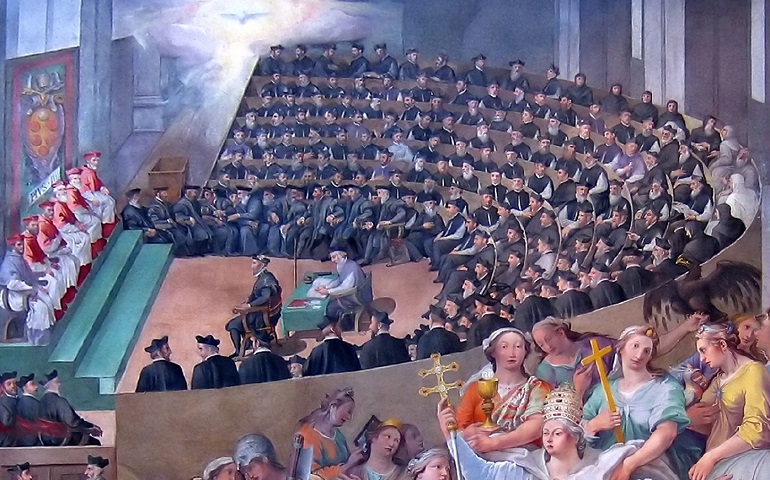
"Council of Trent," a 1588 painting by Pasquale Cati in the Basilica of Santa Maria in Trastevere in Rome (Wikimedia Commons/Anthony Majanlahti)
Editor's note: "Take and Read" is a weekly blog that features a different contributor's reflections on a specific book that changed their lives. Good books, as blog co-editors Congregation of St. Agnes Sr. Dianne Bergant and Michael Daley say, "can inspire, affirm, challenge, change, even disturb."
A History of the Council of Trent
by Hubert Jedin, translated into English by Ernest Graf
Thomas Nelson, 1957-61
When I was working with a colleague on a small book on the sources for the research on the Second Vatican Council (Il concilio inedito: fonti del Vaticano II, edited by myself and Giovanni Turbanti, 2001), Giuseppe Alberigo, the general editor of the History of Vatican II, the five-volume standard work for the most important Catholic theological event after Trent, managed to convince a young doctoral student that a small book on the sources was the way Hubert Jedin started his own volumes on the history of the Council of Trent.
The last of the four-volume History of the Council of Trent by Jedin (1900-80) was published 40 years ago and it is still one of the most important works of church history published in the 20th century. Jedin's work was given new light by the more recent and brilliant book by John O'Malley, Trent: What Happened at the Council (2013).
O'Malley reminded us not only of the importance of Trent to understand Vatican II and Catholicism today, but also that only the first two volumes of Jedin’s prodigious work have been translated into English. True, Jedin's work was difficult to translate into other languages (all four volumes were translated into Italian, but not one was ever translated into French), also this was also because of the sheer number of pages (more than 2,700).
It is nevertheless one of the paradigm-changing works in Catholic historiography. All historians of modern Catholicism are indebted to Jedin.
The first of the four volumes, published in the early days of postwar Germany, in 1949, opens with a most audacious incipit for a series of volumes focused already on a big event: an entire volume on the pre-history of Trent, introducing what Jedin called "the victory of the papacy over the councils" of the 15th century.
The Catholic historian Jedin was breaking a taboo very much present in Catholic culture in the mid-20th century -- one that was still trying to figure out the implications of the definitions on the papacy approved by the First Vatican Council in 1870 -- about the relations between the papacy, conciliarism and the conciliar tradition itself. Jedin explained the difficult and uneasy relationship between the pope and the bishops gathered in a council not in terms of theological necessity, but in historical terms and with a sense of historical development.
The Council of Trent (1545-63), the most defining moment of early modern Catholicism, for Jedin did not stand alone in church history, but was part of a long and tense history of the Catholic church, and especially of Catholic ecclesiology -- in a sense, the result of the end of 15th-century conciliarism.
The second part of the first volume addresses the history of the attempts to call the council after Martin Luther's call for a church reform that eventually became the Protestant Reformation. Volume 1 ends with a chapter devoted to the opening of the council at Trent, Italy, with just a handful of council fathers -- 25 bishops and five superiors of religious orders, a tiny minority within the Catholic episcopate, not at all representative of what back then was the Catholic world.
Volume 2 (published eight years after the first one, in 1957) focuses on the first session (1545-47) and the transfer of the council south of Trent, that is to Bologna. This was period with key debates on justification, original sin, the number of the sacraments, and the decision on bishops’ obligation to reside in their dioceses.
Volume 3 (published in 1970) analyzes the sessions in Bologna (1547-48) and the second period in Trent (1551-52), which solidified the fracture between Rome and the Protestant reformers. Volume 4, Parts I and II (published in 1975) is about the last period at Trent with the debates on ordination, the Eucharist, indulgences, the saints, and the role of images in devotional practices.
In the conclusion of the work, Jedin analyzes the last three sessions (including the deliberations on the decree on marriage) and draws a final assessment of the contributions made by the most important event in the history of Catholic theology and culture between the 16th and the 19th centuries.
Jedin's "opus magnum" on the history of Trent is indeed one of the monuments of Catholic historiography, and in a sense the highest moment in 20th-century historiography of the councils of the church. Jedin was the most important historian in a church that after World War II -- but still before Vatican II -- was finally accepting the historical-critical method as the approach necessary to understand the church as a historical subject. The church was slowly coming to terms with the limits of conceiving church history still in theological terms, as a "sacred history."
Jedin's History of the Council of Trent was indeed the culmination of his historiographical contribution, which changed the way Catholic historians would look at their profession: abandonment of a strictly confessional and apologetic historiography, the awareness of the limits of the historiographical positivism strictly limited to the publication of sources, and the claim of new spaces opened up by the end of the persecution of "modernists" in the early 20th century.
This shift was made possible in Jedin by his important teachers and intellectual references in Germany (Joseph Wittig, Leopold von Ranke, Sebastian Merkle and Albert Ehrhard), his contemporary colleagues in Italy (the philosopher Benedetto Croce and the historian of heretics Delio Cantimori), and his encounters with the characters and historical events that emerged from the pages of history, starting with Girolamo Seripando, superior general of the Augustinians and a member of the Council of Trent.
Jedin's outstanding contribution was the result of the application of historical-critical method, in a period that followed the liberalization of historical studies with the opening of the Vatican Archives by Pope Leo XIII in 1881, but still characterized by apologetics and theological controversialism. Until Vatican II, Jedin's work was considered not Catholic enough by some guardians of Catholic intellectual orthodoxy.
Jedin’s decision to write a history of the Council of Trent is intimately linked with his path of life. Jedin's mother was Jewish, and that meant for him the withdrawal of the German venia legendi (permission to teach in universities) and the banning from state universities in Nazi Germany. That had brought the young lecturer only the poor position of archivist of the diocese of Wroclaw (back then still in Germany, now in Poland after the postwar boundaries).
After the Kristallnacht of Nov. 9, 1938, it was not safe for Jedin to remain in Nazi Germany. So he decided to return to Rome, where he had lived already, to be the editor of one of the volumes of the prestigious series Concilium Tridentinum, the edition of the historical documents of the Council of Trent.
On Sept. 1, 1939, the Second World War broke out, and Jedin succeeded, thanks to fortunate circumstances, to reach Rome with a suitcase full of material he had collected on the history of the Council of Trent. He stayed in Rome during the course of World War II (including the German occupation of Rome) until the liberation of the city by the Allied forces in June 1944. Jedin kept working -- even in those difficult conditions during the war -- in the Vatican Archives. The first volume of his history of the Council of Trent was published in 1949.
Jedin's work gave us – four centuries after the end of the Council of Trent in 1563! – the first reliable and definitive history of the most important event in the history of the Catholic church between Martin Luther and Vatican II. This four-volume history put an end to the controversies between the two polar opposites dominating Catholic scholarship on Trent until Jedin: the anti-papal and polemical history of the council by the Venetian Paolo Sarpi (published in 1619 and immediately put on the Index of Prohibited Books) and the official, apologetic history by the Jesuit Pietro Sforza Pallavicino (published in 1656-57).
That was possible because as a first step in the work to the history of the council, Jedin wanted to take a look at the archival sources and their use. This preparatory part of the work, originally conceived as an introduction to the History, became a self-standing book published in 1948: Das Konzil von Trient: Ein Überblick über die Geschichte seiner Erforschung (The Council of Trent: Overview of the History of the Research). Interestingly, Jedin called this little introductory work "my best book."
The ramifications of Jedin's work go well beyond the field of specialists of Trent and the Tridentine era. If we have the standard History of Vatican II directed by Alberigo (published 1995-2001, in five volumes, published in seven languages, English edition by Joseph Komonchak), it is because there was Jedin's History of the Council of Trent before. Not just because Jedin's work was brought to Italy largely by his student Alberigo (1926-2007), but because the approach to Vatican II by the international team of scholars gathered by the so-called (often insultingly) "Bologna school." They consciously followed Jedin's methodological choices: a wide-ranging attention to many different kinds of sources (official acta, diaries, theological treatises, correspondences, political history of the council); the reconstruction of the history of the council, starting with the long prehistory; and a historical study of "what happened" without relying on the mantras of the absolute continuity of church history.
[Massimo Faggioli is a professor of theology and religious studies at Villanova University. His most recent book is The Rising Laity: Ecclesial Movements Since Vatican II.]




